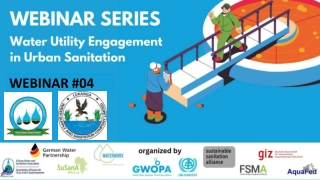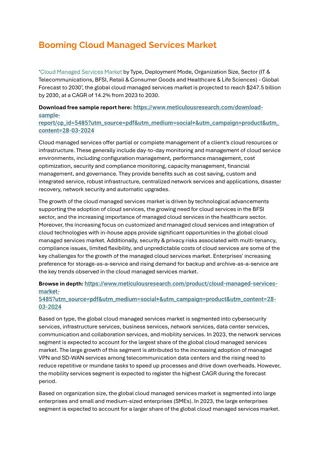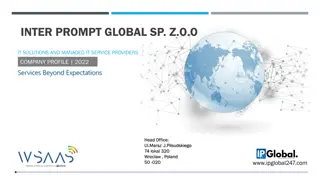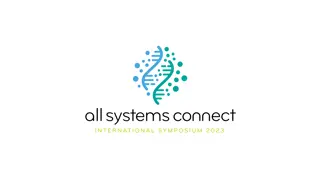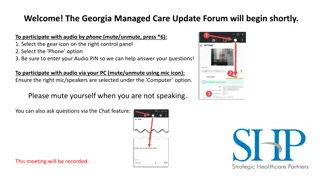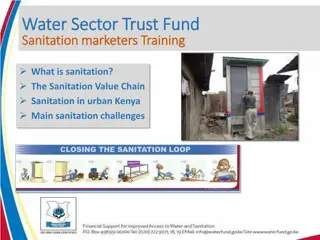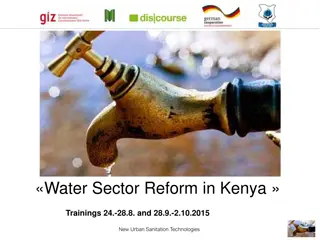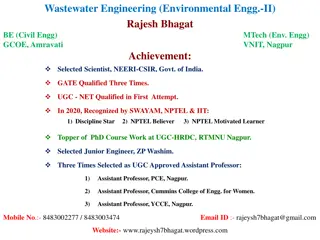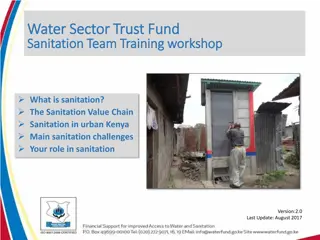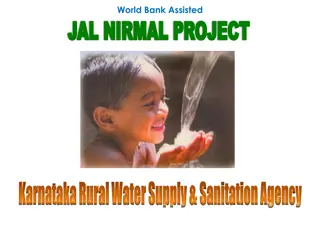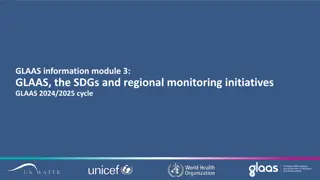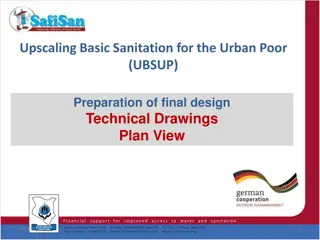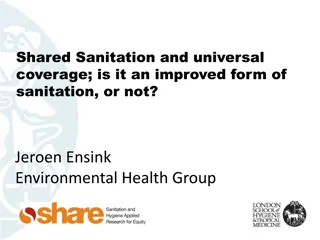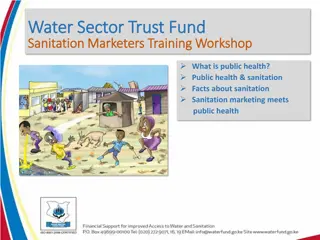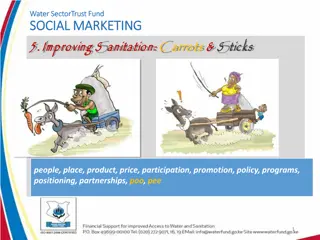Progress on Global Monitoring of Safely Managed Sanitation Services
Presentation on the progress of safely managed sanitation services globally, highlighting the off-track status towards meeting SDG targets. It covers the distribution of on-site and sewered sanitation, wastewater treatment, and challenges in safe management. The project includes pilots in Bangladesh, Ecuador, Indonesia, Kenya, Serbia, and Zambia aimed at monitoring Safely Managed On-Site Sanitation. Optional local indicators for national monitoring are also discussed, emphasizing design standards, functionality, groundwater risk, location, and risks associated with on-site sanitation.
Download Presentation

Please find below an Image/Link to download the presentation.
The content on the website is provided AS IS for your information and personal use only. It may not be sold, licensed, or shared on other websites without obtaining consent from the author.If you encounter any issues during the download, it is possible that the publisher has removed the file from their server.
You are allowed to download the files provided on this website for personal or commercial use, subject to the condition that they are used lawfully. All files are the property of their respective owners.
The content on the website is provided AS IS for your information and personal use only. It may not be sold, licensed, or shared on other websites without obtaining consent from the author.
E N D
Presentation Transcript
Rick Johnston (johnstonr@who.int) Tom Slaymaker (tslaymaker@unicef.org) Progress on global monitoring of safely managed sanitation services Subtitle of presentation
JMP 2021 progress report https://washdata.org/report/jmp-2021-wash-households
120 countries had estimates for safely managed services in 2020
The distribution of on-site and sewered sanitation varies widely by region
Many countries have data on treatment of wastewater from sewers
Safe management of onsite sanitation CONTAINMENT EMPTYING TRANSPORT TREATMENT DISPOSAL / REUSE https://www.fsmtoolbox.com/
Few countries have data on safe management of on-site sanitation
Monitoring Safely Managed On Site Sanitation (SMOSS) project Phase 1 pilots (2020 2022) Phase 2 guidance (2022+ ) Annex A (indicators) Annex B (household questionnaire) Annex C (sanitation inspection) Annex D (service authority) Bangladesh Ecuador Indonesia Kenya Serbia Zambia https://washdata.org/monitoring/sanitation/safely-managed-on-site-sanitation
Understanding global vs national indicators Global indicators Examples of optional local indicators for national monitoring - Design standards: sealed cover, wall and base material or permeability, chambers, dimensions, outlet type Functionality: damage, blockage, leaks, sludge depth Groundwater risk: proximity to wells, depth of groundwater, soil characteristics density (volume/area requirements for infiltration) Function: Years operation, size, sludge depth, Risks: Groundwater risk, flood risk Location: on/off premises, distance from house Safety: covered, how buried, buried in rainy season, groundwater risk, proximity to waterways / residents Reuse: contents used after less than 2 years storage Emptying frequency: years, regular or scheduled Method: manual, mechanical (type of equipment) Safety to workers: PPE/protection, not entering pit Safety to user/public: no spillage, flushed to drain Accessibility: location of containment, presence of lid/manhole, street access Method of transport: manual (cart), motorized, Safety to workers: PPE/protection during transport Safety to user/public: no spillage, covered transport, vehicles not used for water supply Design standards: meets national standards for faecal sludge treatment facilities; treatment adequately level for the risk of exposure to the effluent Function: Systems function, not overloaded/ reasonable capacity, not damaged, leaking, overflowing or bypassed. Containment is not overflowing or discharging waste directly to the surface environment - - Containment - - - - Contained, not emptied Disposed in-situ Contained, emptied, buried in-situ - - - - - - - - - - Emptying If containment ever emptied Excreta delivered to off-site treatment facility Transport Designed to provide treatment for both solid and liquid phase Treatment -
SMOSS example household survey questions Does your septic tank or pit latrine have an outlet pipe for liquid effluent? If it has an outlet pipe for liquid effluent, where does this pipe discharge? In the last year, have excreta from your (pit latrine or septic tank) been released to the surface environment due to any of the following events? Has your (pit latrine or septic tank) ever been emptied? The last time it was emptied, where were the contents emptied to?
SMOSS sanitation inspections Sanitary inspection forms New version under preparation Digital format with mobile app (mWater) https://www.who.int/teams/environment-climate-change-and-health/water-sanitation-and-health/sanitation- safety/sanitation-inspection-packages
Conclusions Strengthening national systems for monitoring SDG targets Harmonization of data between and within countries Indicators, definitions, methods Many countries have data on WWT but few have data on SMOSS Containment is a big issue (sanitation inspections rare in LMICs) Few countries have nationwide data on treatment of faecal sludge Moving from one off surveys/inspections towards routine data from service providers and regulators (urban and rural) Integrating and analyzing data from multiple data sources
All Systems Connect 2023 is made possible thanks to the generous support of our partners including the World Health Organization and :



